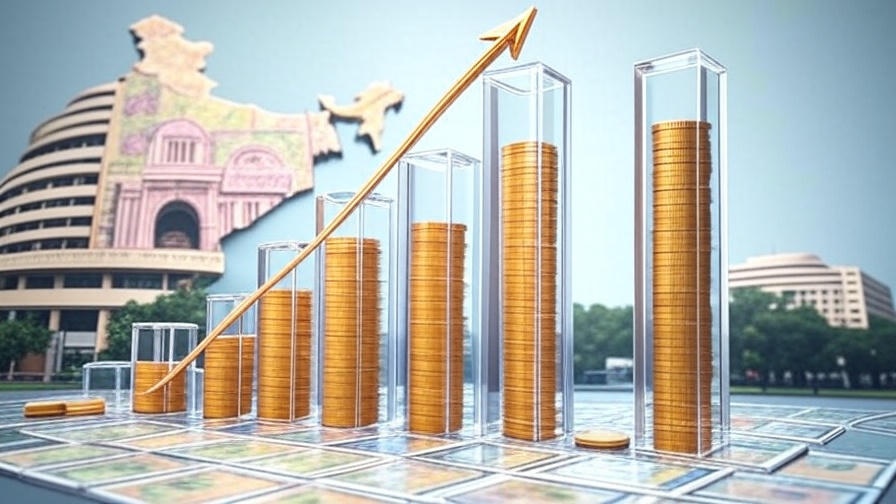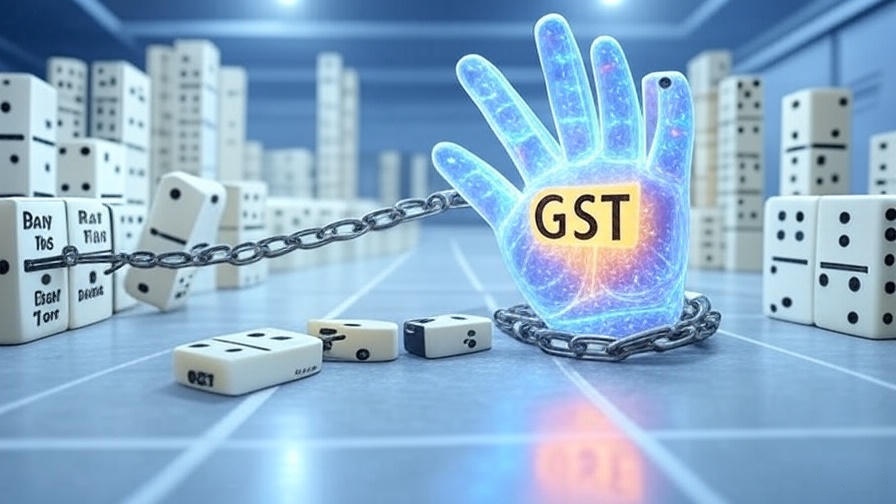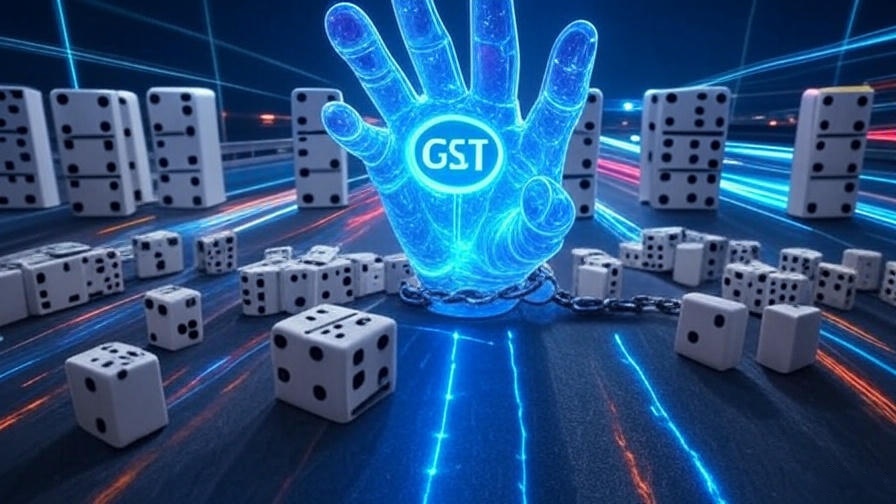Examining the GST India success and challenges after eight years reveals a tale of monumental achievement and persistent hurdles. Eight years ago, India took a bold leap with the Goods and Services Tax (GST), promising to transform the nation’s complex tax landscape into a unified, efficient system. Today, as we examine the numbers and narratives surrounding this ambitious reform, the picture is both impressive and incomplete.
The Revenue Revolution: Numbers That Speak Volumes

The most compelling argument for GST’s success lies in its revenue performance. The fiscal year 2024-25 witnessed gross GST collections reaching a record ₹22.08 lakh crore, marking a healthy 9.4% year-on-year growth. This isn’t just a one-off achievement – it represents a consistent upward trajectory that has seen monthly average collections climb from ₹1.2 lakh crore in the early years to over ₹1.8 lakh crore today.
The tax-to-GDP ratio tells an equally encouraging story, exceeding 6% in six out of seven years since implementation. This consistency demonstrates that GST has evolved from an experimental policy to a reliable fiscal backbone for the nation.
The Compliance Success Story

Expanding the Tax Net
One of GST’s most significant achievements has been broadening India’s tax base. The taxpayer registration count has swelled to over 1.5 crore by March-end, representing a substantial expansion of formal economic participation. This growth reflects not just policy success but a fundamental shift in how businesses engage with the tax system.
Digital Infrastructure Triumph
The technological backbone supporting GST deserves special mention. With over 95% return filing consistency maintained for two consecutive years, the digital infrastructure has proven its worth. The e-way bill system (an electronic document required for the movement of goods worth over a certain value, ensuring tax compliance) and electronic invoicing have captured nearly 90% of all transactions, significantly reducing tax evasion while simplifying compliance for legitimate businesses.
Economic Efficiency Gains: Beyond Revenue Collection

GST’s impact extends far beyond government coffers. The input tax credit (a system where businesses can claim credit for the GST they paid on inputs, preventing tax on tax) system has eliminated the cascading effect of taxes (a situation where a tax is levied on a price that already includes a tax, leading to an inflated final cost), directly reducing production costs for businesses. This efficiency gain eventually benefits consumers through lower prices and improved product availability.
To understand this concept in more detail, you can explore this Investopedia article on the cascading effect.
Logistics Revolution
The removal of inter-state checkpoints has delivered tangible improvements in logistics efficiency. Transportation time reductions of up to 20% in some sectors have translated into significant cost savings, making Indian businesses more competitive both domestically and internationally. This enhanced efficiency is a crucial factor as Indian conglomerates like Reliance Industries break into the global tech elite and compete on a worldwide stage.
The Other Side of the Coin: Persistent Challenges

Despite these achievements, the GST journey hasn’t been without bumps. A balanced view of GST India success and challenges requires looking at the persistent issues that critics and experts continue to highlight.
The Complexity Conundrum
Even after eight years of operation, a significant perception persists that GST law remains complex and places considerable compliance burden on taxpayers. This sentiment, echoed by tax experts and former officials, is particularly strong among small and medium-sized enterprises (SMEs). Easing this burden is critical, as the success of ambitious national projects, like the vision for Bengal’s defence manufacturing dream driven by 90 lakh MSMEs, hinges on a simplified and supportive tax environment.
The Rate Rationalization Puzzle
Perhaps the most politically sensitive challenge facing GST is rate rationalization. Tax consulting firms and experts have long advocated for merging the 12% and 18% slabs into a unified 15-16% bracket. However, this remains a “political hot potato” because:
- Any merger would inevitably increase rates for items currently in the 12% bracket.
- Moving items to the 5% slab would result in significant revenue losses.
- Neither the Centre nor states are willing to bear the revenue impact.
Blocked Credits and Procedural Bottlenecks
The system still grapples with blocked credits and procedural inefficiencies that prevent GST from achieving its originally intended neutrality. These technical issues may seem minor but significantly impact business cash flows and operational efficiency. For more technical details on GST rules, the official Central Board of Indirect Taxes and Customs (CBIC) portal is a valuable resource.
The Unfinished Business

Tobacco Taxation Concerns
A specific area requiring attention is tobacco product taxation. Since GST’s introduction, there have been no significant tax increases on tobacco products, raising concerns among public health experts about missed opportunities to discourage consumption while generating additional revenue.
What Lies Ahead: The 9th Year Priorities

As GST enters its ninth year, the roadmap appears clear. Policymakers and tax experts have identified four key priorities:
- Rate rationalization to create a more logical tax structure
- Reducing blocked credits to restore system neutrality
- Broadening the tax base to include more sectors, such as petroleum and electricity. This is particularly relevant as GST policy could significantly impact national goals like advancing India’s EV dreams against China’s magnet monopoly.
- Removing procedural bottlenecks for smoother operations
Realistic Expectations
While dramatic changes like reducing four major slabs to three seem unlikely, incremental improvements are expected. The focus will likely be on refining the existing framework rather than revolutionary changes.
The Balanced Perspective

GST’s eight-year journey presents a classic case of a policy that has succeeded in its primary objectives while leaving room for improvement. The revenue growth and compliance improvements are undeniable positives that have strengthened India’s fiscal position.
However, the persistent complexity concerns and pending rationalization issues suggest that the story of GST India success and challenges is far from complete. The challenge for policymakers is balancing revenue imperatives with the need for simplification – a task that requires both political will and technical expertise.
Looking Forward

The continuous rise in collections and expanding taxpayer base indicate that GST has successfully stabilized India’s indirect tax regime. Yet, the loudest voices in tax policy circles continue to call for simplification and rationalization. A stable tax system provides a predictable fiscal environment, which is essential for navigating the strategic shuffles and big money moves on Dalal Street, where foundational economic policies heavily influence investor confidence.
As India’s economy grows and evolves, so must its tax system. The ninth year of GST will likely be defined by incremental improvements rather than sweeping changes, as policymakers work to fine-tune a system that has proven its fundamental worth while acknowledging areas that need attention.
The journey of GST India success and challenges exemplifies policy implementation in a complex democracy – achieving significant success while constantly adapting to address legitimate concerns and changing economic realities.
Disclaimer: This analysis is for informational purposes only and should not be considered as financial, investment, or tax advice. Readers should consult qualified professionals for specific guidance related to their business or investment decisions. The views expressed are based on publicly available information and current policy understanding.
